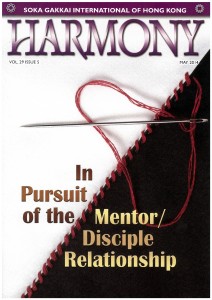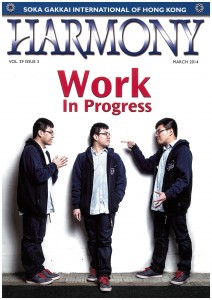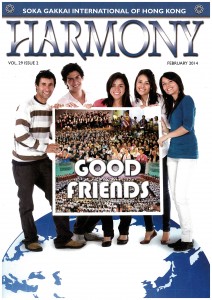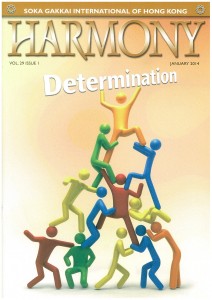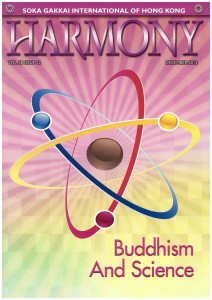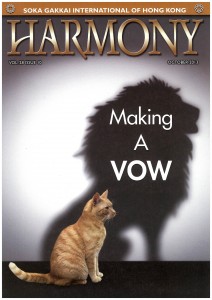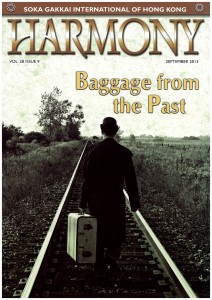Wed, 30th Apr 2014
Category : Harmony, News (All), Publication
DEAR MEMBERS AND FRIENDS OF SGI,
This month we celebrate May 3rd, Soka Gakkai Day. It was on this day that both Mr. Toda and Mr. Ikeda were inaugurated as the second and third presidents respectively of the Soka Gakkai. In light of the occasion, we look at the Mentor-Disciple relationship in this issue of Harmony.
As you will read in our Special Features, the Mentor-Disciple relationship is of great significance in Nichiren Buddhism. All of us today are able to change our lives through faith in this Buddhism because of the Mentor-Disciple relationship. It is something that dates back to the beginnings of Buddhism. As was so eloquently explained in The Human Revolution(p.1965): “It takes a human being to raise and foster another human being. The mentor and disciple relationship had been a core element of Buddhism from its earliest days. Buddhist practice has its origins in those who decided on their own accord to embrace the Buddha, Shakyamuni, as their mentor, following him and listening to him preach the Law. The mentor-disciple relationship of Buddhism is different from any societal system or contract. It is always based on the free and spontaneous will of the individual, and expression of that person’s seeking spirit. It has nothing to do with personal gain or self-interest. It is a spiritual bond of the purest kind, arising from a desire to pursue a life dedicated to the highest truth. Because of this, the bond of mentor and disciple is as strong and imperishable as a diamond.”
The Mentor-Disciple relationship in Buddhism is not one that is top-down, or even bottom-up. The mentor does not look down at the disciple, thinking they are superior and above everyone else. At the same time, the disciple does not put the mentor on a pedestal as someone who is blindly worshiped or idolized. It is an egalitarian relation, where both the mentor and the disciple are deeply committed to advance together in faith.
The disciple holds deep respect for whom the mentor is, for the merit of what has been achieved and what the mentor still wants to accomplish. The disciple embraces the mentor’s vow as his or her own, walking side-by-side, as the work together to achieve this shared commitment; the happiness of all people.
As you will read from President Ikeda’s quote in our Viewpoint; “The relationship between mentor and disciple can be likened to that between needle and thread. The mentor is the needle and the disciple is the thread. When sewing, the needle leads the was through the cloth, but in the end it is unnecessary and it is the thread that remains and holds everything together.”
We hope you enjoy this issue of Harmony.
Skip Williams
Quotes of the Month:
“One who refuses to seek the advice of others will eventually be led to a path of ruin. A mentor helps you to perceive your own weaknesses and confront them with courage. The bond between mentor and protégé enables us to stay true to our chosen path until the very end.”–www.ikedaquotes.org
HARMONY-April 2014
Wed, 2nd Apr 2014
Category : Harmony, News (All), Publication

DEAR MEMBERS AND FRIENDS OF SGI,
One of the best things about this Buddhism is that initially, you don’t have to understand how it works in order for you to gain benefit. You just need to take the action to chant. It’s a bit like flicking a light switch to enjoy the effect of electricity. You don’t need to understand how it gets there to have light in your room.
And that’s a really good thing, because early on in my practice, all I cared about was chanting, doing activities and changing stuff in my own life, with no thought of others. A rather self-centered approach, which can happen when first beginning to chant.
Sure, I read the various publications, mostly to see if any of my photos were used, but I didn’t understand a lot of the Buddhist principles, some of the more complex, yet fundamental concepts of this Buddhism, nor ultimately, my life.
For that is what Buddhist practice is about, our life. How we can lead the most value creating and victorious life possible and help others to do the same. And only when we study and understand the inter-relatedness of all things, are we able to elevate our Buddhist practice to the next level.
This is why reading the various SGI publications is so crucial. It helps us understand the subtle yet complex workings of our life, our environment, and the universe.
This month we look at the principle of the Ten Factors. The Ten Factors is a very important concept that explains how we relate to everything around us. They, together with the Ten Worlds and the Three Realms, form part of the “3,000 realms in a single moment of life”, as was first explained by T’ien-t’ai.
How do we get to 3,000 you may ask? In a nutshell, it consists of the 10 worlds, which are mutually inclusive, from Hell to Buddhahood, and each contains the other – so 10 x 10 = 100. Then each of the 100 interact with the 10 factors at any given time – so 100 x 10 = 1,000. These 1,000 relate to the three realms we dwell in – our self, other beings and the environment – resulting in 1,000 x 3 = 3,000. For more details, see our special features and the graph on page 14.
Comprehending this important concept is key to our personal growth and the deepening of our faith. For understanding this allows us to understand our life, our environment and the world around us.
We hope you enjoy this issue of Harmony.
Skip Williams
Quotes of the Month:
“Prayer entails an intense challenge to believe in yourself and stop diminishing yourself. To belittle yourself is to disparage Buddhism and the Buddha within your life.”–www.ikedaquotes.org
HARMONY-March 2014
Wed, 5th Mar 2014
Category : Harmony, News (All), Publication
In this months’ Harmony we look at the concept of Human Revolution from this slightly different angle – viewing it as a non-stop, ongoing process from birth to death and beyond.
When we regard our life as a work in progress, we can strive to continue to improve ourselves. It does not mean that we have to become overly critical or dissatisfied with ourselves, but rather that we humbly embrace ourselves, as we are, while living with the awareness that there is always something that we can improve on.
We often find the answers to what needs improving right in front of us, but it takes wisdom to see. That is precisely why we chant – to develop the wisdom and courage to address the areas in our life we’d rather not touch upon.
We are responsible for our own life and experiences, and it is often the very people and situations that irritate and annoy us the most that will teach us the lessons we need to learn. Nichiren Daishonin describes how our environment reflects our inner self, and that we, and our environment, are inseparably one and the same (esho funi). By observing our surroundings and those around us who will display and mirror life-conditions and characteristics that we also have, we can learn and understand where we need to do more work on ourselves. So perhaps, rather than complain and criticize others, we can observe and ask ourselves: “What is it that I can learn from you and this experience?”
Life rarely ever goes as planned. It is what we make of our situation, how we face our obstacles courageously and continue our faith and contribution to worldwide kosen-rufu, in spite of challenges, that makes us a person of strength with a winning life.
It is with great sadness that we had to say goodbye to one such person, our good friend and senior leader, Angie Robinson, who left this life on February 13, 2014. Angie truly embraced the concept of “work in progress”. Even during the last days of her life she was cheerful and positive, visiting and encouraging members in Kuala Lumpur, never allowing her fragile health to stop her from the mission she had chosen.
Angie was a founding member of Harmony when it began as a newsletter. Over the years she worked tirelessly and was a key contributor and advisor to the magazine as we continued to improve on format and content. On behalf of the Harmony Team, thank you Angie, for everything.
A leader who spoke at Angie’s memorial service said that: it is not the length of one’s life that is important, but what we do with the time that is available to us that makes for a great life.
Let’s continue to work tirelessly on ourselves and help others along the way.
Carola Chard
Quotes of the Month:
“Youthfulness originates from life-force. There are young people who look surprisingly old, and there are elderly people who, no matter how the years pass, always sparkle with the glow of youth, an inner vitality.” –www.ikedaquotes.org
HARMONY-February 2014
Wed, 5th Mar 2014
Category : Harmony, News (All), Publication
HARMONY-January 2014
Mon, 6th Jan 2014
Category : Harmony, News (All), Publication
Happy New Year! As is tradition in the SGI and throughout the world, now is the time to make fresh resolutions for 2014. We hope that this issue of Harmony, with its theme of “Determination”, will help you keep your resolve strong in “The Year of Opening a New Era of Worldwide Kosen-rufu”.
Determinations are easy to make, but can be hard to maintain.
That separates a true determination from wishful thinking is conviction. You can have great intent; however, without a strong willingness to do what it takes, combined with concrete action, it will only amount to empty words.
We practice this Buddhism to make the impossible possible, not just get by with whatever life and our karma throws our way.
To set the course of our life, we need a strong wind in our sail – our Buddhist practice, and a destination – our determinations and goals.
When we embrace a determination to work for kosen-rufu, a vow to help others become happy, our sails are always full and we race towards the shores of our destination. Then, once we get there, it is off to another shore, another destination, another goal. The important thing is to begin by making a vow, a determination, and then follow it up with decisive action.
Belief in one’s self and one’s abilities has a direct correlation with the ability and willingness to follow through with determinations. If you don’t think you can do something, or constantly doubt yourself, you won’t succeed. It doesn’t matter how young or old you are, for self-doubt has no age restrictions. “Believe you can and you’re halfway there.”*
The important thing is to believe in yourself, your Buddhahood and that of others as we move our lives forward “The essence of Buddhism lies in developing oneself through one’s own determination and tenacious effort – not by depending on anyone or anything else. At the same time, neither is it to be confused with the arrogance to suppose, ‘I alone am correct and respect-worthy.’ To believe in the immense potential with oneself is at once to believe in the immense potential existing with all people. Buddhism teaches that we should treasure the lives of others just as highly as we treasure our own.”**
Let’s make 2014 a truly victorious year as we make strong determinations and take courageous actions to challenge our self-imposed limitations, share this wonderful approach to life with others, and make our wildest dreams come true.
* Teddy Rossevelt www.brainyquotes.com
** Daisaku Ikeda www.ikedaquotes.org
Skip Williams
Quotes of the Month:
Quotes of the Month:
“Nothing is stronger than one’s determination in the moment. The immovable resolution of a single person will, in the end, move the world.”—Human Revolution p. 647
Treasures of heart
Mon, 16th Dec 2013
Category : Latest News, News (All)
Treasures of heart ~Animated children’s stories by Daisaku Ikeda
A rotating selection of films available in English on this website!!
Web Site: http://treasures-of-heart.com/
* The content will switch on a fortnightly rota. Please check the online broadcast schedule.
HARMONY-December 2013
Thu, 5th Dec 2013
Category : Harmony, News (All), Publication
We are happy to announce that the SGI has just launched a new website, the Nichiren Buddhism Library. The SGI has made available on-line The Writings of Nichiren Daishonin, volumes I and II, The Lotus Sutra and Its Opening and Closing Sutras, The Record of the Orally Transmitted Teachings, and, as a reference to assist with study of these works, The Soka Gakkai Dictionary of Buddhism. All five of these books can now be found in searchable format at www.nichirenlibrary.org.
This month we look at the relationship between Buddhism and science.
With a seeking mind for finding truth, scientists have raised questions about the validity of religion from the very beginning of their academic research and it often appears that science and religion take diametrically opposing views. Religion is largely requiring a faith-based trust, and science demands actual proof of the stated findings, making it appear that they will never agree or find common ground.
Buddhism is one of my favorite subjects in which to engage in a meaningful, thought provoking, and sometimes heated dialogue. In my almost 30 years of chanting, I have had discussions with so many interesting people from diverse backgrounds. Each person I talked with was shaped by their unique experience in life that gave them a different view and perspective. Based on their culture and religious tradition, they had varying degrees of understanding and openness to views other than their own.
Each individual has different ways of receiving and learning new information. Some, when I tell them that they have the Buddha nature and that by chanting Nam-myoho-renge-kyo they can overcome anything, start chanting that very day. Others have been more cautious and skeptical and demand that I “prove it”. So, to demonstrate the validity of chanting I relate one of my many personal experiences of the benefits of this Buddhism, or I share those of others.
There are those who ask me to explain the workings of Buddhism in scientific terms. Some analytical people want to see empirical data and evidence to support the concepts of Buddhist philosophy before they will embrace it. That’s great. I tell them that over 12 million people in 192 countries and territories wouldn’t be chanting if it weren’t beneficial. Faith in this Buddhism is not blind faith. Buddhism encourages a practitioner to have a seeking mind, and based on practice and study, faith develops and deepens with time. But we have to take action and chant ourselves to experience it. Theory alone is not enough. For example, reading the user manual does not give us the experience of what it feels like to drive a car.
The great thing about Nichiren Daishonin’s Buddhism is that it is very logical and practical in its approach. Science is just starting to embrace theories and arrive at the same conclusions that Buddhism has been expounding for thousands of years. From the micro to the macro, from cells to the vastness of the universe, Buddhism covers it all.
As you will read in our special features and viewpoints, Buddhism and science actually do agree on many levels!
Skip Williams
Quotes of the Month:
“Science is based on tested proof or empirical evidence. You conduct a test or experiment and then observe the results. Nichiren Daishonin’s Buddhism, similarly, teaches that nothing beats actual proof. In this regard, it stands alone among world religions.” —Daisaku Ikeda, FIA p.4
HARMONY-November 2013
Mon, 11th Nov 2013
Category : Harmony, News (All), Publication
Dear members and friends of SGI,
Each year, on November 18th, we celebrate Soka Gakkai Founding Day. We recognize the unwavering commitment and accomplishments of our three founding presidents and the debt of gratitude we owe them.
I wonder if sometimes we don’t take for granted the struggles of these three courageous men, who stood up against all odds for the happiness of you and me.
If it were not for their unselfish dedication to bring hope and happiness to others by building an organization that allows for the sharing of this Buddhism, we would most likely not be practicing Nichiren Buddhism today.
Nichiren Daishonin’s Buddhism would have stayed within the confines of a small number of priests in Japan and would not be practiced today by millions of people around the world, enabling us to experience first hand the magnificent benefits of chanting Nam-myoho-renge-kyo. As a result of embracing this philosophy, we can transform our lives and our friends’ lives. When we change, the world will change. This is the formula for our human revolution.
This year, November 18th will be truly historic, as it marks the completion and opening of the new central Soka Gakkai Headquarters Building in Tokyo. Our cover image is an architectural rendering of this impressive structure.
As President Ikeda states: “The Soka Gakkai Headquarters is a ’fighting citadel’ from which we direct our efforts for kosen-rufu, while fending off the three powerful enemies and other negative forces. That’s why Mr. Toda insisted that the Headquarters building be functional, sturdy, and simple.”
As you will read in our special features, the foundation for our kosen-rufu movement has been laid. We are now building towards a new future, as evidenced by the realization of President Ikeda’s vow to his mentor, President Toda, to construct a magnificent new castle for kosen-rufu; thus, signifying the SGI’s advance as a world religion.
“Soka Gakkai buildings are golden citadels of mentor and disciple, symbols of our unshakable unity.”
With a renewed spirit, let us courageously, joyfully and wisely advance in all endeavors, as we share the life transforming philosophy of Nichiren Daishonin with those around us.
Skip Williams
Quotes of the Month:
“The way to peace is to expand the ranks of capable people who possess a stand-alone spirit. When you encourage one person, you create hope. When you connect with one person, you spread peace.”
—Daisaku Ikeda, World tribune, 18 October 2013, p.7
HARMONY - October 2013
Thu, 3rd Oct 2013
Category : Harmony, News (All), Publication
This month we look at what it means to make a vow.
When we hear the word vow, we often think of it as something religious, marital or even political. Simply put, a vow is a pledge, an oath, a promise or a commitment to do something. A vow is made first in thought but then it must be followed up by action, otherwise it is not a vow, it is just wishful thinking.
We can make vows many times a day and they can come in various degrees of intensity and altruism. A vow to get up on time, to be a nicer person at work, to lose weight, or to help a suffering friend become happy.
We may not consciously say to ourselves “I VOW to…” We may word it as “I determine to …” or “I’m going to …”. We reserve the word “vow” for important commitments. But when we set about on a course of action, and work hard not to deviate from it, that is what we are doing, making a vow. If we are not careful to continuously re-determine ourselves, our vows can start to lose their intensity and slip away, becoming empty, meaningless words.
In Buddhism, making a vow for kosen-rufu is the greatest commitment, and I completely changes the way our practice and life unfolds. When we make a vow to help other people become happy, we realize our own potential. We may feel like a house cat, but through making a vow for something as noble as kosen-rufu, we unleash the lion with. We overcome our lesser-self and reveal our greater-self; we become a lion king.
When we look at the lives of the three founding presidents of the Soka Gakkai, we can see first hand the power and transformative impact of what making a vow for kosen-rufu means; not only for the individual, but for society as a whole.
We are able to practice this Buddhism because of their vow to share this Buddhism and help people overcome their sufferings and become truly happy. They fully embraced the spirit of the oneness of mentor and disciple.
Never underestimate the power of a vow by one individual. All it takes is one person to stand side by side with their mentor and work for the happiness and benefit of others; to challenge their own personal situation, win in their life and show others how it is done through chanting Nam-myoho-renge-kyo.
As we read this month’s issue of Harmony, let’s think about our own vow that what we can do to actualize it.
Skip Williams
Quotes of the Month
“One who refuses to seek the advice of others will eventually be led to a path of ruin. A mentor helps you to perceive your own weaknesses and confront them with courage. The bond between mentor and protege enables us to stay true to our chosen path until the very end.” (Daisaku Ikeda, www.ikedaquotes.org)
HARMONY - September 2013
Thu, 5th Sep 2013
Category : Harmony, News (All), Publication
Like our cover image suggests, in this month’s Harmony we are addressing old baggage, and how to let go of it with the support of a strong Buddhist practice.
We all too often venture on the journey of life weighted down by the baggage we carry with us. We may not even want to, let it go thus lightening our load. Sometimes it can seem so heavy and burdensome that we feel we can go on farther. We may feel that it is all just too much. We are stuck with this load that will stay with us always.
So why don’t we just let go of what is holding us back and make it easier for us to move forward? Easier said then done!
I really like the analogy of the elephant that is tethered to the ground by a rope. This rope could easily be broken by the adult animal, but the elephant has been tied up since a very young age and is now conditioned that this is as far as he can go, and deems it impossible to break free. It might have been the case when he was small, but not now. However, the elephant thinks that what was once true in the past must be true now, so doesn’t even try to break free.
How often do we – just like the elephant – use the past as an excuse, a justification, to hold us back from achieving what we really want?
The choices we make in the present are shaped by our past, our karma, our experiences, and we decide on our action or inaction. Are we letting ourselves be held back like the elephant? Are we stuck in the past and not moving forward because we are carrying around heavy baggage that can be discarded if we just let go?
You can’t move forward if you’re always looking back.
When we let our past dictate our future, we are allowing our fundamental darkness to take hold. We need to recognize this and believe in our own Buddhahood so that we can break through.
By chanting Nam-myoho-renge-kyo, we can push back this critical voice of our fundamental darkness and re-determine ourselves to be victorious. When we raise our life condition by chanting, we can win even in the most adverse conditions. We prove to ourselves and others that our past doesn’t have to control or inhibit our forward movement.
As you will read in this issue, our past does not limit the potential of who we can become in the future. Let’s develop unwavering trust that through our prayers and sincere actions, we will change our karma and make even the seemingly impossible possible.
So let’s drop the bags and break the rope; travel light, and enjoy the journey!
Skip Williams
Quote of the month
“Our live are ruled by impermanence. But simply realizing that changes nothing. There is no value in bleak pessimism. The challenge is how to create something of enduring value within the context of our impermanent lives. The lotus sutra teaches us how to do this.” – Daisaku Ikeda FIA p.16
Available at all HKSGI Culture Centres

